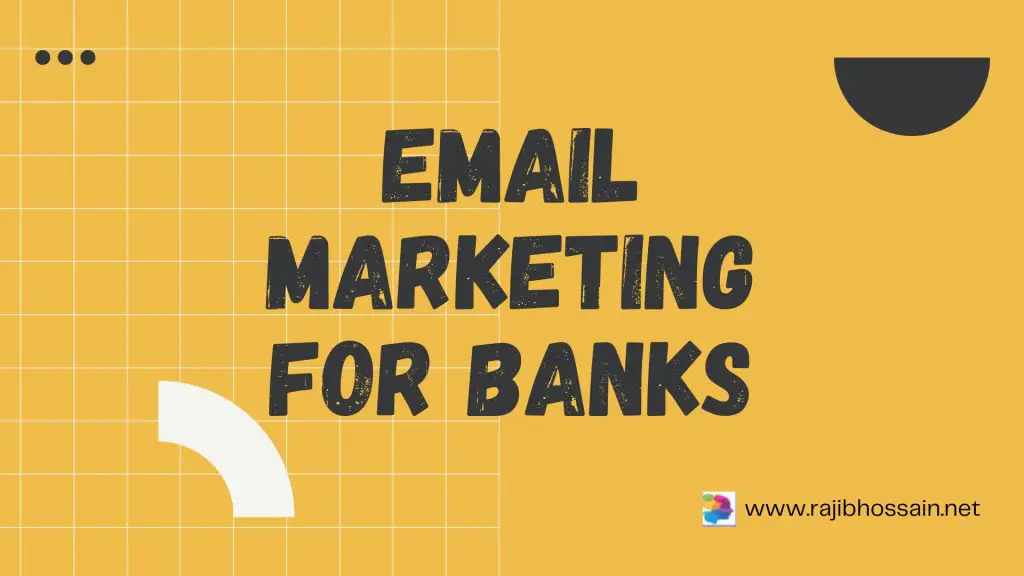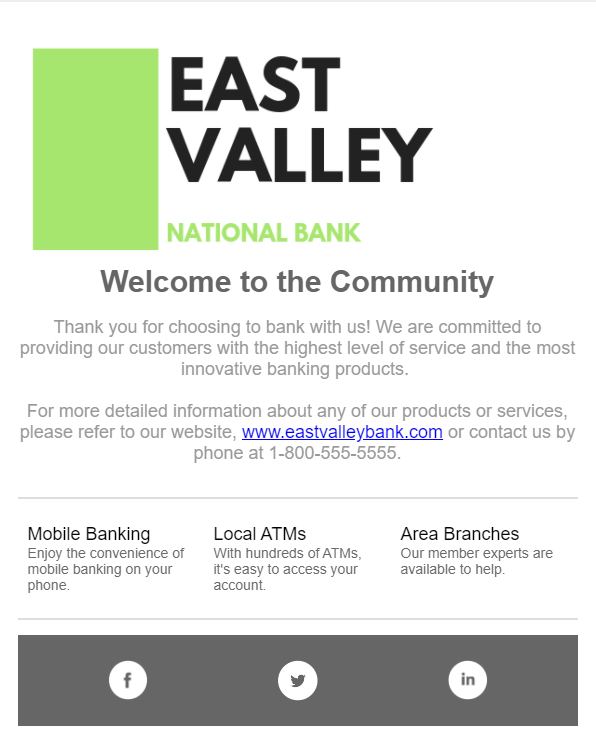
Introduction
Email marketing for banks helps build customer relationships and drives engagement with personalized, relevant content. Banks benefit greatly from email marketing.
It offers a direct line to customers, enabling personalized communication and fostering loyalty. Emails can inform customers about new products, services, and promotions. They also provide educational content, helping customers make informed financial decisions. Effective email marketing campaigns can segment audiences, ensuring each customer receives the most relevant information.
This targeted approach increases open rates and engagement. With regulatory compliance, banks can securely communicate important updates. Email marketing also allows for tracking metrics, offering insights into customer behavior and preferences. Consequently, banks can refine their strategies, improve customer experiences, and boost overall satisfaction.
Email Marketing In The Financial Sector
Email marketing has become crucial in the financial sector. Banks use email to connect with customers. It helps in sharing important updates and offers. Email marketing is cost-effective and efficient. It ensures personalized communication with clients.
Rise Of Digital Communication
The digital age has transformed communication. People prefer online interactions over traditional methods. Banks now use digital channels to reach customers. Email is a key tool in this transformation. It allows banks to send timely messages and updates.
Digital communication is fast and reliable. Customers receive information instantly. Email marketing also supports document sharing. It is essential for sending statements and notices.
Email Vs. Other Channels
| Channel | Advantages | Disadvantages |
|---|---|---|
| Cost-effective Personalized messagesInstant delivery | Spam filtersRequires internet access | |
| Phone Calls | Direct interactionImmediate feedback | Time-consumingHigh cost |
| SMS | Quick delivery High open rates | Limited message lengthLess detailed information |
Email marketing offers several benefits over other channels. It provides detailed information. It is also more personalized. Banks can segment their audience. This ensures targeted communication.
Email marketing is cost-effective. It requires less investment than phone calls. The ROI is also higher. Banks can track email performance easily. This helps in improving future campaigns.
Targeting The Right Audience
Email marketing for banks can be highly effective. It’s crucial to target the right audience. This approach ensures your messages reach those who need them most. By focusing on key segments and using personalized content, banks can see higher engagement rates.
Segmentation Strategies
Effective segmentation is the first step in targeting the right audience. Banks can use various criteria to segment their audience:
- Demographics: Age, gender, income level.
- Geographic: City, state, country.
- Behavioral: Purchase history, website activity.
- Psychographic: Lifestyle, values, interests.
By segmenting their audience, banks can send relevant emails. This increases the chances of engagement and conversions.
Personalized Content
Personalized content is crucial for email marketing success. People respond better to emails that speak directly to them. Here are some ways to personalize content:
- Use the recipient’s name: Address them by their first name.
- Tailor content to their interests: Offer products they are interested in.
- Send timely offers: Provide offers that match their buying cycle.
- Include personalized recommendations: Suggest services based on their history.
Personalization makes the recipient feel valued. This leads to higher open rates and more clicks.
| Segmentation Criteria | Example |
|---|---|
| Demographics | Young professionals, retirees |
| Geographic | Urban vs. rural customers |
| Behavioral | Frequent online banking users |
| Psychographic | Eco-conscious customers |
By combining segmentation and personalized content, banks can create powerful email campaigns. These strategies ensure that the right message reaches the right person at the right time.
Creating Effective Email Campaigns
Email marketing can transform how banks connect with their customers. Effective email campaigns keep customers informed and engaged. Here’s how to create email campaigns that hit the mark.
Crafting Compelling Subject Lines
The subject line is your first impression. It determines if your email is opened or ignored.
- Keep it short: Use fewer than 50 characters.
- Be clear and direct: Avoid confusing words.
- Create curiosity: Encourage the reader to learn more.
- Use numbers: Numbers attract attention.
Example:
| Good Subject Lines | Bad Subject Lines |
|---|---|
| “Save $100 on your loan” | “We have an offer for you” |
| “Update your account settings” | “Important information” |
Designing For Engagement
Design plays a crucial role in email engagement. A well-designed email captures attention and encourages action.
- Use a simple layout: Avoid clutter.
- Include clear calls to action: Buttons work well.
- Use images wisely: Too many images can be distracting.
- Ensure mobile-friendliness: Many users read emails on phones.
Example layout:
Welcome to Our Bank!Check out our latest offersView OffersDesign emails to be visually appealing and easy to read. A good design boosts engagement and helps your message shine.

Credit: icbb.bank
Content That Resonates
Email marketing can be powerful for banks. To succeed, your content must resonate with your audience. What does this mean? It means your emails should offer value and be relevant to your customers. This builds trust and keeps them engaged.
Financial Education And Tips
People need help with money. Banks can provide useful tips and advice. Share simple, easy-to-follow financial advice. Offer guidance on saving, budgeting, and investing. Use clear language and short sentences.
- How to save for a rainy day.
- Tips for creating a budget.
- Basics of investing in stocks and bonds.
These tips help customers manage their money better. This builds trust and loyalty. Also, customers see the bank as a helpful partner.
Exclusive Offers And Promotions
Everyone loves a good deal. Banks can send exclusive offers to their email subscribers. These can include special rates on loans, discounts on services, or rewards for new accounts.
| Offer | Details |
|---|---|
| Lower Loan Rates | Get a loan at a lower interest rate. |
| Service Discounts | Save money on banking services. |
| New Account Rewards | Earn rewards for opening a new account. |
Exclusive offers make customers feel special. They also encourage customers to take action. This can lead to more business for the bank.
Automation And Trigger-based Emails
Email marketing for banks has evolved. Automation and trigger-based emails are now essential. These tools help banks engage with customers efficiently. They make communication timely and relevant.
Behavior-driven Messaging
Behavior-driven messaging tailors emails based on customer actions. For example, a customer opens a savings account. The bank can send them tips on saving money. This approach makes emails more relevant.
Behavior-driven emails can include:
- Welcome emails after account creation
- Reminders for incomplete applications
- Promotions based on transaction history
Lifecycle Email Marketing
Lifecycle email marketing follows the customer’s journey. It starts from the first interaction and continues. This strategy ensures continuous engagement.
| Lifecycle Stage | Email Type |
|---|---|
| Onboarding | Welcome Email |
| Engagement | Product Updates |
| Retention | Exclusive Offers |
| Reactivation | We Miss You |
Sending the right email at the right time is key. It boosts customer satisfaction and loyalty.
Compliance And Security Measures
Email marketing for banks demands strict compliance and robust security measures. Banks handle sensitive data. They must adhere to regulations and build trust through privacy. Let’s explore these crucial aspects.
Regulatory Considerations
Banks must follow strict regulations. Non-compliance can lead to heavy fines. Below are key regulations to consider:
- GDPR: Ensures customer data protection in the EU.
- CAN-SPAM Act: Governs email marketing in the USA.
- PCI DSS: Protects payment card information.
These regulations mandate data protection. Banks should stay updated with any changes. Training staff on these laws is crucial.
Building Trust Through Privacy
Trust is vital for banks. Customers need to feel their data is safe. Banks can build trust by implementing strong privacy measures:
- Use encryption for all emails. This protects data in transit.
- Provide clear privacy policies. Customers should know how their data is used.
- Allow easy opt-out options. Respect customer preferences.
Regularly audit security measures. This ensures ongoing compliance and trust. Transparency in data handling builds customer confidence.
| Regulation | Region | Focus |
|---|---|---|
| GDPR | EU | Data Protection |
| CAN-SPAM Act | USA | Email Marketing |
| PCI DSS | Global | Payment Card Data |
Implementing these practices ensures compliance and security. This fosters trust and protects customer data.
Measuring Success And Roi
Email marketing is crucial for banks. Measuring success and ROI is essential. Banks need to know if their email campaigns are working. This section will cover key performance indicators, A/B testing, and analytics.
Key Performance Indicators
Key Performance Indicators (KPIs) help measure email marketing success. Here are some important KPIs for banks:
- Open Rate: This shows how many people open your emails.
- Click-Through Rate (CTR): This measures how many people click links in your emails.
- Conversion Rate: This tracks how many email recipients take a desired action.
- Bounce Rate: This shows how many emails were not delivered.
- Unsubscribe Rate: This measures how many people unsubscribe from your emails.
- Return on Investment (ROI): This calculates the revenue generated from email campaigns.
A/b Testing And Analytics
A/B testing helps improve email performance. It involves sending two versions of an email to see which performs better. Here are the steps for A/B testing:
- Create two versions of an email (A and B).
- Send version A to half of your audience.
- Send version B to the other half.
- Compare the results using KPIs.
Analytics tools help banks understand email performance. Use these tools to track and analyze data. Here are some useful analytics tools:
| Tool | Description |
|---|---|
| Google Analytics | Tracks website traffic from email campaigns. |
| Mailchimp Analytics | Provides detailed email performance reports. |
| HubSpot Analytics | Tracks email engagement and conversion rates. |
Using KPIs, A/B testing, and analytics, banks can measure email marketing success. This helps improve campaigns and increase ROI.

Credit: emarketingplatform.com
Future Trends In Bank Email Marketing
Email marketing remains a powerful tool for banks. It’s essential to stay updated with future trends. Banks need to leverage new technologies and features to stay competitive.
AI And Machine Learning
Artificial Intelligence (AI) and Machine Learning (ML) revolutionize email marketing for banks. These technologies help in personalizing emails. AI can analyze customer data and predict preferences. Banks can send targeted offers to individual customers. This increases customer engagement and satisfaction.
Machine Learning algorithms can optimize email campaigns. They can determine the best time to send emails. They can also identify which content resonates most with customers. This ensures higher open and click-through rates.
| AI & ML Benefits | Description |
|---|---|
| Personalization | Customizes email content for each customer |
| Optimized Timing | Finds the best time to send emails |
| Content Analysis | Identifies effective content for higher engagement |
Interactive Email Features
Interactive emails are the future of email marketing. They engage customers directly within the email. Banks can use interactive elements like:
- Surveys
- Polls
- Quizzes
- Calculators
These features make emails more engaging. Customers can interact without leaving their inboxes. This leads to higher engagement and conversion rates.
Interactive emails also provide instant feedback. Banks can quickly understand customer needs and preferences. This helps in tailoring future email campaigns effectively.
Here is a simple example of an interactive email feature:
Click MeThis button can lead to a survey or special offer. Such features keep customers engaged and increase loyalty.
Frequently Asked Questions
How Do Banks Use Email Marketing?
Banks use email marketing to promote services, share financial tips, and update customers on account activities. They offer personalized offers and enhance customer engagement.
How Should I Email To Attract Customers?
Craft a compelling subject line. Personalize the email content. Highlight clear benefits. Include a strong call to action. Ensure mobile-friendly design.
How Do Banks Advertise Their Services?
Banks advertise their services through online ads, social media, television, radio, and print media. They also use email marketing, sponsorships, and community events to reach potential customers.
Which Email Is Best For Email Marketing?
Mailchimp is the best for email marketing. It offers user-friendly features, automation, and detailed analytics.
Conclusion
Email marketing is a powerful tool for banks. It helps engage customers, boost loyalty, and drive conversions. Use targeted campaigns and personalized content. Track results to optimize strategies. Implementing these tips ensures success in your email marketing efforts. Stay ahead in the competitive banking industry by leveraging email marketing effectively.
